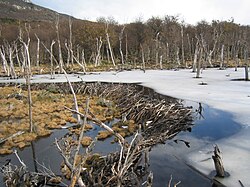Invasive species
An invasive species is a species which is not native to the place where it is found. It has moved from its native area, where it grew naturally, into a new area. Often it becomes a nuisance species, because in its new habitat it lacks its old enemies. Normally, as a species evolves, so do the things which eat it or parasitise it. Free of natural restraints, the invading species outcompetes its new neighbours.
Kudzu, for example, is called "The weed which ate the South" because it went out of control in the southern United States. The introduction of starlings to North America is another example.
Natural events sometimes allow species to invade new places, as in the Great American Interchange.
The sparrow in North America

The house sparrow, Passer domesticus, native to Europe and Asia, has been introduced to North and South America and Australia.
It was introduced deliberately to the U.S.A. in the late 19th century by Eugene Schieffelin. He wanted to introduce to America all the birds mentioned in the works of Shakespeare. Two of these species were great successes: starlings and house sparrows. He organized a society for the importation of foreign birds, incorporated in Albany.[1]
Invasive Species Media
North American beaver (Castor canadensis) dam in Tierra del Fuego
Canada goldenrod (Solidago canadensis) as a roadside weed in Poland
The brown tree snake (Boiga irregularis) has had an impact on the native bird population of the island ecosystem of Guam.
Japanese knotweed (Reynoutria japonica) is considered one of the world's worst invasive species.
Cats (Felis catus) (here, killing a woodpecker) are considered invasive species in Australia and negatively impact wildlife worldwide.
Lantana, abandoned citrus, Sdei Hemed
The Chinese mitten crab (Eriocheir sinensis) may have been purposely introduced in Europe and North America because of its commercial value.
Cargo ship de-ballasting
References
Related pages
+{{{1}}}−{{{2}}}








